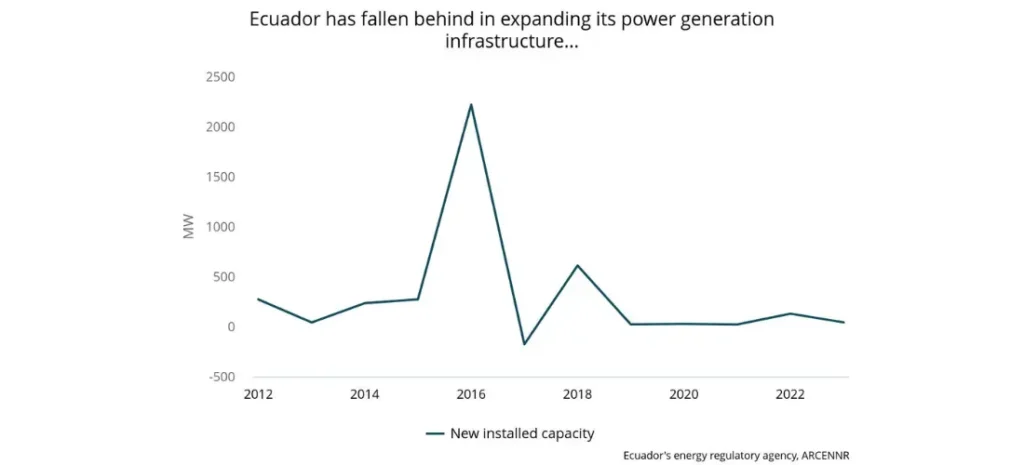
Power outages most likely will continue until late May
Multinationals operating in Ecuador should prepare for extended energy rationing, potentially lasting from mid-April to late May. Rotating personnel and implementing flexible working hours can help mitigate the production impacts caused by power outages. Ongoing energy rationing could limit other activities, such as retail, business operations, and consumer demand, and have an impact on overall economic growth. The blackouts also have the potential to aggravate the tense security situation in Ecuador’s coastal area.
Consider investing in backup power systems such as generators or uninterruptible power supply (UPS) units to ensure the continuity of critical operations during power outages.
Overview
Power cuts have returned to Ecuador, with new rationing affecting more than 20% of national demand and lasting up to eight and a half hours in certain provinces. This resurgence of outages follows Colombia’s decision to halt energy exports to Ecuador to address rationing in its own territory.
With 72% of the country’s electricity supply reliant on hydropower, Ecuador is grappling with severe water scarcity, impacting its capacity to generate electricity; prolonged El Niño phenomena has significantly reduced river stream flows nationwide due to a lack of rainfall.
While Ecuador’s thermal plants could cover up to 25% of the demand, insufficient maintenance has left the entire system operating at just 44% of its total capacity, limiting electricity generation.
The situation has worsened with the closure of the Mazar reservoir, which provides over 1,755 MW of power, representing up to 38% of the national demand. According to the Ministry of Energy Ecuador lacks up to 1.000 MW of power capacity to meet the demand.
Since late 2022, the electricity sector has grappled with supply issues, escalating to power cuts between October 2023 and February 2024, following warnings from the National Center for Energy Control (Cenace) to Guillermo Lasso’s government about worsening drought conditions. Despite announcements from President Daniel Noboa’s government in February 2024 claiming that the crisis was resolved, power cuts unexpectedly resurfaced in April following Colombia’s decision to put a stop to electricity exports which represent about 4% of total Ecuador’s power demand.
The Ecuadorian government has attempted various projects to tackle the energy crisis; yet the execution of these projects has faced significant delays throughout 2024.
- In December 2023, the Electric Corporation of Ecuador (CELEC), a state-owned entity, granted a contract worth USD 58.2 million for the acquisition of 32 Hyundai engines intended to bolster the Quevedo thermal power plant’s capacity by 52 MW. However, only 11 engines have been delivered thus far, with the remaining deliveries postponed due to CELEC’s failure to make payments. CELEC cites liquidity issues, attributing them to another state-owned company, CNEL, owing USD 450 million to CELEC.
- In November 2023, the Minister of Energy and Mines, along with the company Energyquil, signed a concession contract for the installation and operation of a thermal generation plant in Guayaquil. This plant was to comprise four units, each generating 48 MW, totaling 192 MW. Additionally, due to emergency conditions, the ministry requested Energyquil to install an additional small 50 MW generator. As of April, neither the four units nor the additional 50-MW generator have been installed.
- The government awarded multiple renewable energy projects to private companies, including the development of a 200-MW solar park in Manabí and a 1110-MW wind park in Loja. Additionally, other minor concessions totaling 500 MW were granted to private developers. However, these projects have not commenced development due to the absence of a formal mechanism to ensure payment for electricity generation for the contracted companies.
- During Lasso’s tenure, attempts were made to procure 465 MW urgently through barges and land-based generators. However, the process faced obstacles and was ultimately canceled in November 2023 due to permit and financial issues. Despite initial progress, the new government did not restart the procurement process.
- The Ministry of Mines and Energy has confirmed that it is analyzing the offers of three companies for the contracting of barges of 200 to 300 MW of power, within a period of 20 days. Nevertheless, the agreement has not been ratified.
Our View
At this juncture, it appears unlikely that the government will be able to establish enough additional capacity to address the energy crisis. Without substantial rainfall, Ecuador is likely to face continued scheduled rationing, possibly extending into May.
These rationing measures would restrict both production and consumption through late April and early May. If blackouts persist into the night, there is a risk of heightened local crime in the areas most affected, potentially impeding the ongoing efforts of the Noboa administration in combating organized crime.
At FrontierView, our mission is to help our clients grow and win in their most important markets. We are excited to share that FiscalNote, a leading technology provider of global policy and market intelligence has acquired FrontierView. We will continue to cover issues and topics driving growth in your business, while fully leveraging FiscalNote’s portfolio within the global risk, ESG, and geopolitical advisory product suite.
Subscribe to our weekly newsletter The Lens published by our Global Economics and Scenarios team which highlights high-impact developments and trends for business professionals. For full access to our offerings, start your free trial today and download our complimentary mobile app, available on iOS and Android.
